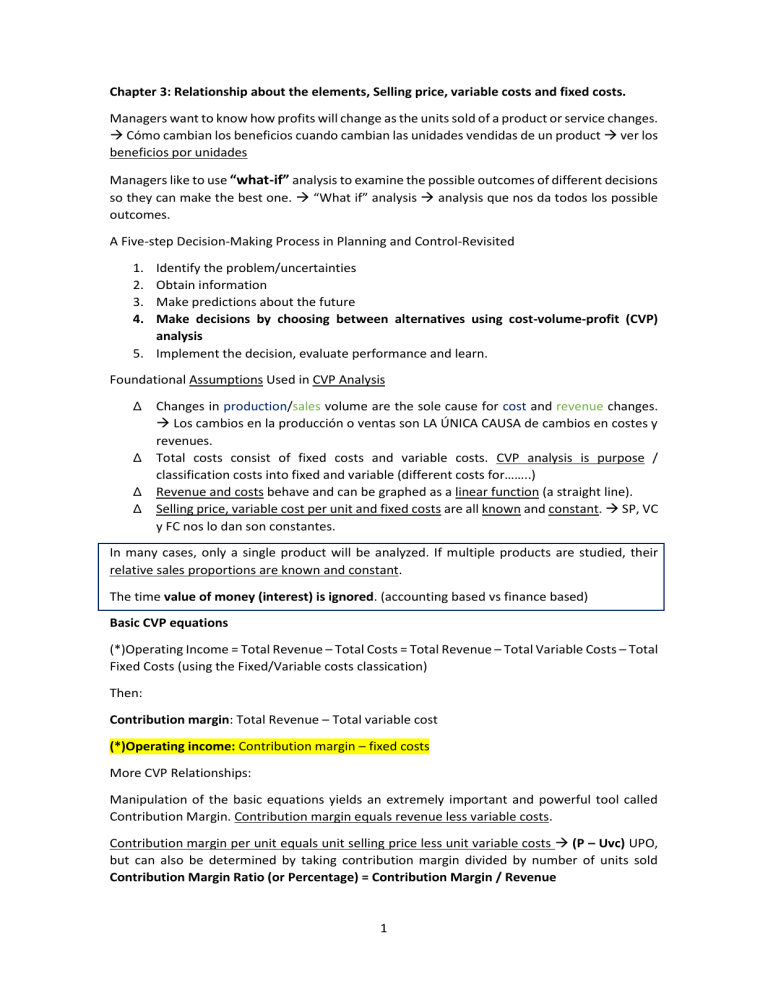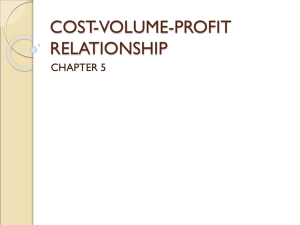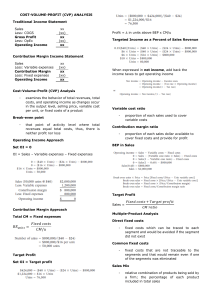
Chapter 3: Relationship about the elements, Selling price, variable costs and fixed costs. Managers want to know how profits will change as the units sold of a product or service changes. Cómo cambian los beneficios cuando cambian las unidades vendidas de un product ver los beneficios por unidades Managers like to use “what-if” analysis to examine the possible outcomes of different decisions so they can make the best one. “What if” analysis analysis que nos da todos los possible outcomes. A Five-step Decision-Making Process in Planning and Control-Revisited 1. 2. 3. 4. Identify the problem/uncertainties Obtain information Make predictions about the future Make decisions by choosing between alternatives using cost-volume-profit (CVP) analysis 5. Implement the decision, evaluate performance and learn. Foundational Assumptions Used in CVP Analysis ∆ ∆ ∆ ∆ Changes in production/sales volume are the sole cause for cost and revenue changes. Los cambios en la producción o ventas son LA ÚNICA CAUSA de cambios en costes y revenues. Total costs consist of fixed costs and variable costs. CVP analysis is purpose / classification costs into fixed and variable (different costs for……..) Revenue and costs behave and can be graphed as a linear function (a straight line). Selling price, variable cost per unit and fixed costs are all known and constant. SP, VC y FC nos lo dan son constantes. In many cases, only a single product will be analyzed. If multiple products are studied, their relative sales proportions are known and constant. The time value of money (interest) is ignored. (accounting based vs finance based) Basic CVP equations (*)Operating Income = Total Revenue – Total Costs = Total Revenue – Total Variable Costs – Total Fixed Costs (using the Fixed/Variable costs classication) Then: Contribution margin: Total Revenue – Total variable cost (*)Operating income: Contribution margin – fixed costs More CVP Relationships: Manipulation of the basic equations yields an extremely important and powerful tool called Contribution Margin. Contribution margin equals revenue less variable costs. Contribution margin per unit equals unit selling price less unit variable costs (P – Uvc) UPO, but can also be determined by taking contribution margin divided by number of units sold Contribution Margin Ratio (or Percentage) = Contribution Margin / Revenue 1 Break-even point The breakeven point (BEP) is that quantity of output sold at which total revenue equals total cost - that is, the quantity of output sold results in $0.00 of operating income. BEP= Ingresos = costes Beneficio u Operating income = 0 Recall our contribution margin method equation: [(SP x Q) - VC x Q)] - FC = OI. If we set OI to 0 and solve, we’ll get the BEP. At BEP, operating income = 0 and contribution margin is equal to the amount of fixed costs! Breakeven Point-Extended: Profit Planning/Target Income The breakeven formula can be modified to become a profit planning tool by adding target operating income to fixed costs in the numerator Let’s say that Tiny wants to make $30,000 Operating Income: Qty of Units = (FC + Target Operating Income)/CM per unit Q = ($20,000 + $30,000)/$250, Q= 200 Using CVP Analysis for Decision Making IMP Remember Tiny? As is, he expects to sell 100 cabinets. What if Tiny spent $5,000 on advertising and estimated that it would increase his sales by 10%. Should he do it? To find out, we can use CVP analysis as follows: As we see from the prior screen, though Tiny’s sales increase with the advertising expenditure, his Operating Income decreases by $2,500. Tiny will be better off if he doesn’t advertise. What if I told you that a more detailed analysis indicated that Tiny’s sales would increase by 25% instead of 10%. Should he do it? Here’s a quick way to check that. If sales increase 25%, they’ll increase by 25 units. 25 units X Contribution Margin per unit of $250 ($600 - $350) = $6,250 That is $1,250 greater than the $5,000 Tiny would have to spend. Another way to see it would be: OI= ((600*125)-(350*125))-25000 = 6250$ So, in this case, Tiny will be better off spending money on the advertising. The concept of using CVP analysis for decision making works just as well if you are thinking about decreasing prices. If you decrease your price, you’d expect more unit sales. To determine if the combination of lower price with higher unit sales will improve Operating Income, use CVP 2 analysis. Para determinar si un menor precio de nuestro producto nos conduciría a mayores ventas usaríamos el CVP análisis. This type of strategic decision entails risk. We use CVP to evaluate how the Operating Income will change but we cannot be certain that our estimates of increased sales will occur. Managers use electronic spreadsheets to systematically and efficiently conduct CVP-based sensitivity analysis to test how sensitive their conclusions are to different assumptions. Sensitivity Analysis CVP provides structure to answer a variety of “what-if” scenarios. “What” happens to profit “if”: o o o Selling price changes Volume changes Cost structure changes Variable cost per unit changes Fixed costs change As an example, if a company determines that an advertising campaign costing $15,000 is expected to increase sales 25%, should they proceed? This is very similar to the analysis we did for Tiny’s Cabinets. The question cannot be properly answered without doing this type of analysis. Margin of Safety-Defines The margin of safety calculation answers a very important question: If budgeted revenues are above the breakeven point, how far can they fall before the breakeven point is reached. In other words, how far can they fall before the company will begin to lose money. Cómo de lejos pueden caer, antes de que la empresa empiece a perder dinero. Margin of safety – An indicator of Risk The margin of safety (MOS) measures the distance between budgeted sales and breakeven (BE) sales: MOS = Budgeted Sales - BE Sales The MOS ratio removes the firm’s size from the output and expresses itself in the form of a percentage: MOS Ratio = MOS / Budgeted Sales Cost Structure Managers make strategic decisions that affect the cost structure of the company. The cost structure is simply the relationship of fixed costs and variable costs to total costs. We can use CVP-based sensitivity analysis to highlight the risks and returns as fixed costs are substituted for variable costs in a company’s cost structure (para resaltar los riesgos y los rendimientos a medida que los costos fijos se sustituyen por costos variables en la estructura de costos de una empresa) The risk-return trade-off compensación riesgo-rendimiento across alternative cost structures can be measured as operating leverage. 3 Operating Leverage = CM / Operating Income Operating leverage describes the effects that fixed costs have on changes in operating income as changes occur in units sold and contribution margin. Describe los efectos que tienen los fixed costs en el operating income as changes in sales y en el contribution margin occurs. Organizations with a high proportion of fixed costs in their cost structures have high operating leverage. High fixed cost = high operating leverage In the presence of fixed costs, the degree of operating leverage is different at different levels of sales. Using Operating Leverage to estimate changes to Operating Income We can use Operating Leverage to estimate changes to Operating Income that will result from a percentage change in sales. (Operating Leverage X % Change in Sales = Percentage change in Operating Income) For example, if sales increase 50% and operating leverage is 1.67, you should expect operating income to increase 83.5% (1.67 x 50%) CVP for Service and Not-For-Profit Organizations CVP isn’t just for merchandising and manufacturing companies. Service and Not-For-Profit businesses need to focus on measuring their output which is different from the units sold that we’ve been dealing with. For example, a service agency might measure how many persons they assist or an airline might measure how many passenger miles they fly. What measure might a hotel use? A restaurant? Contribution Margin vs Gross Margin Recall from Chapter 2 that Gross Margin = Revenue – Cost of Goods Sold In Chapter 3, we learned about Contribution Margin which is Revenue – All Variable Costs Gross Margin measures how much a company charges for its products over and above the cost of acquiring or producing them. Cúanto cobra la empresa por cada producto POR ENCIMA de lo que le cuesta a ella producirlo. Contribution Margin indicates how much of a company’s revenue is available to cover fixed costs. CM= Cúanto de mi revenue me queda para cubrir mis fixed costs. This is especially significant in the manufacturing sector where businesses carry inventory (!!) EXAMPLE: Contribution Margin and Gross Margin for Tiny’s Cabinets (Produced 100 cabinets, sold 90;SP $600; VC $350; FC $20,000 (15,000 Mfg)) 4 45000 -> 350*90+150*90 9000 = 5400045000 Mfg costs Manufacturing costs are the costs incurred during the production of a product. These costs include the costs of direct material, direct labor, and manufacturing overhead _____________________________________________________________________________ Gross profit vs contribution margin A regular income statement shows the Gross Profit. a.k.a = also known as We can learn the contribution margin by restating the regular income statement absortiong costing income statement … A regular income statement shows profits built up from net sales to gross profits and operating income. (We assume no other income and expenses) Sales (100 units @ $100) $10 000 Cost of goods sold (100 units @ $45) 4500 Gross Profit 5500 Operating expenses 2500 Operating income 3000 Manufacturing cost (per unit) Direct materials 15 Direct labour 20 Variable manufacturing overhead 4 (*) Fixed overhead per unit 6 Total manufacturing cost per unit 45 (*) Si subiera nuestro volume de producción, los fixed overhead per unit cambiarian. Si producieramos 200 en vez de 100, los overhead per unit serían 3. Variable selling expenses (100 units x $7.00) Fixed selling expenses General and administrative expenses Total operating expenses 700 800 1000 2500 5 Contribution margin income statement: Sales Variable costs Contribution margin Fixed cost Operating income 10000 ((4+15+20)*100)+700= 4600 10000-((4+15+20)*100)+700)= 5400 6*100+800+1000= 2400 3000 6







